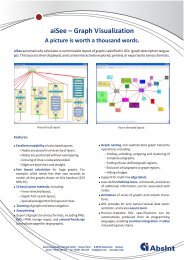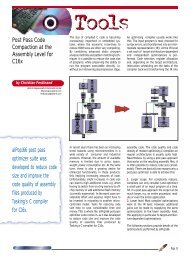Worst-Case Execution Time Prediction by Static Program ... - Absint
Worst-Case Execution Time Prediction by Static Program ... - Absint
Worst-Case Execution Time Prediction by Static Program ... - Absint
Create successful ePaper yourself
Turn your PDF publications into a flip-book with our unique Google optimized e-Paper software.
• aiT is based on the theory of Abstract Interpretation thus offering a provably correct relation to the architecture’s<br />
semantics.<br />
7 Conclusion<br />
aiT enables one to develop complex hard real-time systems on state-of-the-art hardware, increases safety, and<br />
saves development time. It has been applied to real-life benchmark programs containing realistically sized code<br />
modules. Precise timing predictions make it possible to choose the most cost-efficient hardware. Tools like aiT<br />
are of high importance as recent trends, e.g., X-<strong>by</strong>-wire, require the knowledge of the WCET of tasks.<br />
References<br />
[1] AbsInt Angewandte Informatik GmbH. aiSee Home Page. http://www.aisee.com.<br />
[2] Patrick Cousot and Radhia Cousot. Abstract Interpretation: A Unified Lattice Model for <strong>Static</strong> Analysis of<br />
<strong>Program</strong>s <strong>by</strong> Construction or Approximation of Fixpoints. In Proceedings of the 4th ACM Symposium on<br />
Principles of <strong>Program</strong>ming Languages, Los Angeles, California, 1977.<br />
[3] Christian Ferdinand. Cache Behavior <strong>Prediction</strong> for Real-<strong>Time</strong> Systems. PhD thesis, Saarland University,<br />
1997.<br />
[4] Christian Ferdinand, Reinhold Heckmann, Marc Langenbach, Florian Martin, Michael Schmidt, Henrik<br />
Theiling, Stephan Thesing, and Reinhard Wilhelm. Reliable and precise WCET determination for a reallife<br />
processor. In Proceedings of EMSOFT 2001, First Workshop on Embedded Software, volume 2211 of<br />
Lecture Notes in Computer Science, pages 469–485. Springer-Verlag, 2001.<br />
[5] Reinhold Heckmann, Marc Langenbach, Stephan Thesing, and Reinhard Wilhelm. The influence of processor<br />
architecture on the design and the results of WCET tools. Proceedings of the IEEE, 91(7):1038–1054, July<br />
2003. Special Issue on Real-<strong>Time</strong> Systems.<br />
[6] Marc Langenbach, Stephan Thesing, and Reinhold Heckmann. Pipeline modeling for timing analysis. In<br />
Proceedings of the 9th International <strong>Static</strong> Analysis Symposium SAS 2002, volume 2477 of Lecture Notes in<br />
Computer Science, pages 294–309. Springer-Verlag, 2002.<br />
[7] Thomas Lundquist and Per Stenström. Timing anomalies in dynamically scheduled microprocessors. In<br />
Proceedings of the 20th IEEE Real-<strong>Time</strong> Systems Symposium, December 1999.<br />
[8] Florian Martin, Martin Alt, Reinhard Wilhelm, and Christian Ferdinand. Analysis of Loops. In Kai<br />
Koskimies, editor, Proceedings of the International Conference on Compiler Construction (CC’98), volume<br />
1383 of Lecture Notes in Computer Science, pages 80–94. Springer-Verlag, March /April 1998.<br />
[9] Jörn Schneider and Christian Ferdinand. Pipeline Behavior <strong>Prediction</strong> for Superscalar Processors <strong>by</strong> Abstract<br />
Interpretation. In Proceedings of the ACM SIGPLAN Workshop on Languages, Compilers and Tools for<br />
Embedded Systems, volume 34, pages 35–44, May 1999.<br />
[10] John A. Stankovic. Real-<strong>Time</strong> and Embedded Systems. ACM 50th Anniversary Report on Real-<strong>Time</strong> Computing<br />
Research, 1996. http://www-ccs.cs.umass.edu/sdcr/rt.ps.<br />
[11] Henrik Theiling. Extracting Safe and Precise Control Flow from Binaries. In Proceedings of the 7th Conference<br />
on Real-<strong>Time</strong> Computing Systems and Applications, Cheju Island, South Korea, 2000.<br />
[12] Henrik Theiling. Generating Decision Trees for Decoding Binaries. In Proceedings of the ACM SIGPLAN<br />
Workshop on Languages, Compilers and Tools for Embedded Systems, pages 112–120, Snowbird, Utah,<br />
USA, June 2001.<br />
[13] Henrik Theiling and Christian Ferdinand. Combining abstract interpretation and ILP for microarchitecture<br />
modelling and program path analysis. In Proceedings of the 19th IEEE Real-<strong>Time</strong> Systems Symposium, pages<br />
144–153, Madrid, Spain, December 1998.





